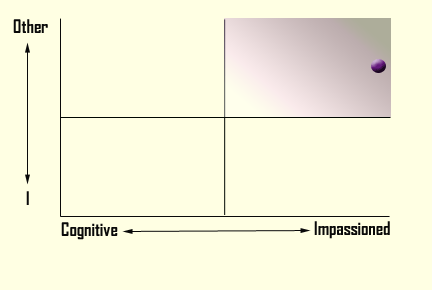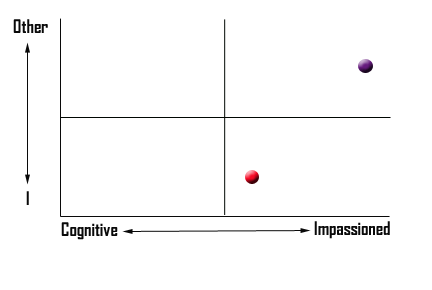So, like we do many weekend mornings (which usually take place in the afternoon), a few weeks ago Brand and I end up in a long discussion about life, the universe and gaming. In this particular discussion, we ended up building a rather nifty (if I do say so myself) character diversity classification system. Like Myers Briggs, it uses a set of four dyads to create sixteen archetypes. Unlike MBTI, it also uses an activity gauge and an influence scale which I’ll probably tackle in a later post. I’m also not likely to get into each individual archetypes in this post (we’ll see if I ever bother to go that deep).
So first: the point.
The point is that I love heuristic systems that help you look at play and play structure from different angles and learn something new from it. The point is that I love rich diverse worlds full of rich diverse people – especially NPC’s. The point is that I love shorthands that carry a punch in the middle of play. Lastly, the point is that it would be handy to have a system with which to evaluate your games for diversity and simultaneously help you expand it.
This is a system built out of our current game, which is the new novella of our pseudo historical swashbuckling bodice ripper. We ran it through superheroes and sword and sorcery and horror and other action genres in general and it seems to work for many. There are probably other dyads which work better for other genres specifically.
So second: The four dyads.
Disclaimer: There’s no good or bad of any pair. Neither path is more effective. If you have good or bad associations with any word, or find yourself wanting to privilege one word over its pair, get over it. If you hate classification systems or personality tests or archetypal processing, it’s also a good idea to either get over it or go read something else on the wide world of the interwebs that will be interesting or compelling to you. That said… we’re off!
Strategic / Tactical
Strategic characters are long range, systemic thinkers. They look well ahead, prepare resources, plan for the use of those resources before, during, and after an action. Their strategies may be, and often are, contextually complex and based on investigation – that is to say that their stratagems need not be simple nor rigid, but they are based on forethought and planning.
Tactical characters are people who excel at dealing with problems encountered in the middle of action. they don’t waste their time planning things out ahead of time, because they’ll do best just dealing with it as they arrive. They don’t design and smuggle in a plastic gun to kill the enemy spy, they know that there’ll always be a handy beer bottle or ballpoint pen that’ll do.
Offensive / Defensive
Offensive characters are, well, offensive. They don’t sit back and wait for their nemesi to come
to them, they go after them (and whatever else they want) head first. They’re ambitious; where there is no apparent opportunity they make or force an opportunity.
Defensive characters are then, defensive. They look for ways to protect their fortunes, their loved ones, their duty or themselves. Spider man is a defensive character. He responds to trouble and tries to keep the world secure in it’s present state. He goes after the bad guy because the bad guy has MJ, or because the bad guy’s dangling a bus full of school children off a bridge, not because he’s known to be bad and is out there somewhere.
Physical / Social
Physical characters respond first in a physical way. they punch their opponents or order their deaths. They favour war over diplomacy. To console their loved ones, they hug them, to seduce they brush up or go in for the kiss. They consider the body or physical arena as the first and best course of action.
Social characters respond first in a social way. They try to talk their way out of trouble. They undermine their opponents by starting rumours about them, or having their debts called in. They cajole or incite through social manipulation. They seduce with a classic line, a killer smile and impromptu poetry. The first instinct is to talk, and they often talk a lot even when a confrontation turns physical.
Rational / Intuitive
Rational characters do things for reasons. The reason doesn’t have to be a sane reason, it just has to come from a rationale. If you stop them and ask them why they are doing what they are doing, they’d generally be able to articulate it. They are often self-reflective, and can tell you what and why they feel the way they do.
Intuitive characters do things because they do things. The things that they do may well be (and often are) the most logical things to be done if you were to sit down and analyze it, but the intuitive character wouldn’t necessarily be interested in or able to tell you why. They follow their gut without evidence or a reason to back it up – it is what will happen.
So pick a character that you’ve played, PC or NPC and identify their preferences among the dyads.
Olivia, my character in the swashy bodice ripper is a Tactical Offensive Social Intuitive. She swings into action with her sword and a plan and the iron clad belief that she’ll succeed. As soon as she has enough information to know who she’s up against or where the thing she wants is, she goes after it head on, asap. She tries to talk, taunt or seduce her way in or out of any trouble she comes across; even though she is a sword master, her school is based on tagging and seductive distraction. She feels powerful things, very powerfully, but couldn’t ever really identify or articulate why she’s feeling that way and is about as reflective as a rock. I might know exactly why she does the things she does, but she most often doesn’t have a clue.
Try it out.
Suggestions for you out there who might be grooving on this, some of which I might dig into later:
- Have a look at the kinds of archetypes the combinations produce.
- Type out all the NPCs in a game you’re running and use the empty slots for new characters to expand the breadth of the cast
- Type out the NPC’s against gender, race, or other criteria and see what your game is inadvertently saying by concentration or absence
- Type out your past PC’s and look for ones you’ve never tried for a future adventure.

